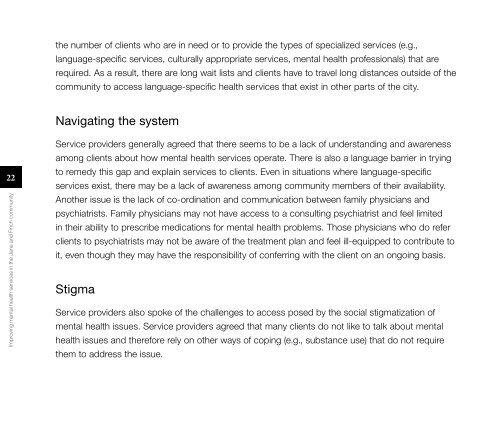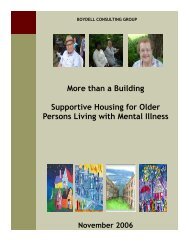Improving Mental Health Services in the Jane and Finch Community
Improving Mental Health Services in the Jane and Finch Community
Improving Mental Health Services in the Jane and Finch Community
Create successful ePaper yourself
Turn your PDF publications into a flip-book with our unique Google optimized e-Paper software.
<strong>the</strong> number of clients who are <strong>in</strong> need or to provide <strong>the</strong> types of specialized services (e.g.,language-specific services, culturally appropriate services, mental health professionals) that arerequired. As a result, <strong>the</strong>re are long wait lists <strong>and</strong> clients have to travel long distances outside of <strong>the</strong>community to access language-specific health services that exist <strong>in</strong> o<strong>the</strong>r parts of <strong>the</strong> city.Navigat<strong>in</strong>g <strong>the</strong> systemService gapsConcerns were expressed about <strong>the</strong> availability of services for men. Men are perceived as oftenbe<strong>in</strong>g less will<strong>in</strong>g than women to seek services, <strong>and</strong> <strong>the</strong>re is a lack of specialized services for <strong>the</strong>m.There are also underly<strong>in</strong>g mental health issues that <strong>in</strong>fluence <strong>in</strong>volvement with <strong>the</strong> justice system,which are often not considered. This speaks to a lack of early <strong>in</strong>tervention for <strong>in</strong>dividuals at riskwith<strong>in</strong> <strong>the</strong> community.22to remedy this gap <strong>and</strong> expla<strong>in</strong> services to clients. Even <strong>in</strong> situations where language-specificservices exist, <strong>the</strong>re may be a lack of awareness among community members of <strong>the</strong>ir availability.Service providers <strong>in</strong>dicated that services <strong>in</strong>volv<strong>in</strong>g collaborations with o<strong>the</strong>r organizations were23Ano<strong>the</strong>r issue is <strong>the</strong> lack of co-ord<strong>in</strong>ation <strong>and</strong> communication between family physicians <strong>and</strong>work<strong>in</strong>g well with<strong>in</strong> <strong>the</strong> <strong>Jane</strong> <strong>and</strong> F<strong>in</strong>ch community. Where one organization lacked a service,psychiatrists. Family physicians may not have access to a consult<strong>in</strong>g psychiatrist <strong>and</strong> feel limitedano<strong>the</strong>r organization could step <strong>in</strong> <strong>and</strong> serve <strong>the</strong>ir clients <strong>in</strong> that area. Service providers also<strong>in</strong> <strong>the</strong>ir ability to prescribe medications for mental health problems. Those physicians who do referidentified support groups as a key resource <strong>in</strong> <strong>the</strong> <strong>Jane</strong> <strong>and</strong> F<strong>in</strong>ch area. They reported that clientsclients to psychiatrists may not be aware of <strong>the</strong> treatment plan <strong>and</strong> feel ill-equipped to contribute tofound support groups very useful, especially groups without wait lists, <strong>and</strong> that many clientsit, even though <strong>the</strong>y may have <strong>the</strong> responsibility of conferr<strong>in</strong>g with <strong>the</strong> client on an ongo<strong>in</strong>g basis.accessed <strong>the</strong>m. O<strong>the</strong>r programs that service providers thought were work<strong>in</strong>g well were “holistic,”<strong>in</strong> that <strong>the</strong>y looked at <strong>the</strong> whole person, balanc<strong>in</strong>g an ethno-specific approach with a focus on<strong>Improv<strong>in</strong>g</strong> mental health services <strong>in</strong> <strong>the</strong> <strong>Jane</strong> <strong>and</strong> F<strong>in</strong>ch communityService providers generally agreed that <strong>the</strong>re seems to be a lack of underst<strong>and</strong><strong>in</strong>g <strong>and</strong> awarenessamong clients about how mental health services operate. There is also a language barrier <strong>in</strong> try<strong>in</strong>gStigmaService providers also spoke of <strong>the</strong> challenges to access posed by <strong>the</strong> social stigmatization ofmental health issues. Service providers agreed that many clients do not like to talk about mentalhealth issues <strong>and</strong> <strong>the</strong>refore rely on o<strong>the</strong>r ways of cop<strong>in</strong>g (e.g., substance use) that do not require<strong>the</strong>m to address <strong>the</strong> issue.Promis<strong>in</strong>g practices<strong>in</strong>dividuals’ unique experiences, separate from whatever group <strong>the</strong>y might identify <strong>the</strong>mselves asbelong<strong>in</strong>g to. Service providers noted that services worked well when <strong>the</strong>y were brought directlyto <strong>the</strong> people—an example of this is settlement services with<strong>in</strong> schools. F<strong>in</strong>ally, service providers<strong>in</strong>dicated that language-specific services worked well for <strong>the</strong>ir clients. They suggested that <strong>in</strong>F<strong>in</strong>d<strong>in</strong>gs









